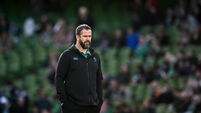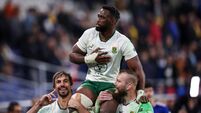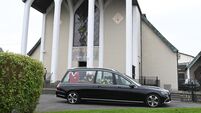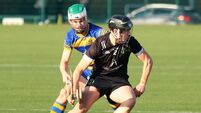Donal Lenihan: After a defeat like that, you hate to see the media officer come your way
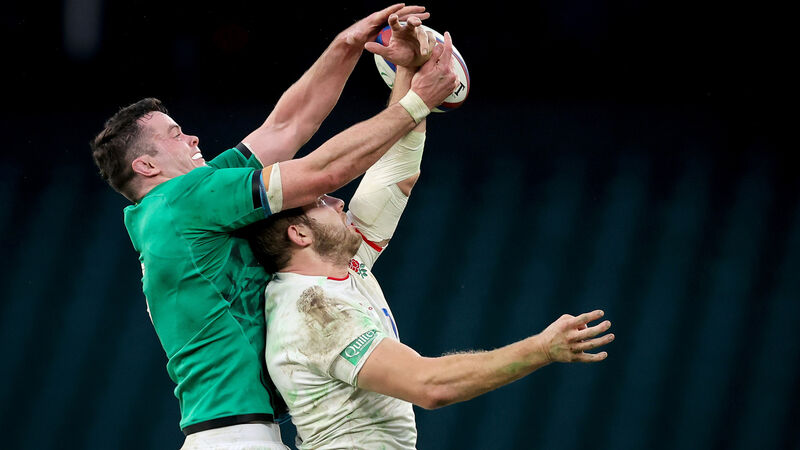
Ireland's James Ryan attempts to seal possession in a line out against Joe Launchbury of England. Picture: INPHO/Billy Stickland
As a player, just about the last person you want to see approaching you in the dressing room in the aftermath of a defeat is the media officer. He needs a few players to front up to the press, to answer their questions without throwing anyone under the bus.
It can be difficult. You are hurting, physically and mentally, and have had little or no time to process what’s just after happening on the field. In situations like this, a fourth defeat to England on the bounce, the press officer wants an experienced head, someone who has been there before.
Despite starting the last two games on the bench, Conor Murray was plucked from the pack to muse over what just happened in a strange game in Twickenham last Saturday. Strange from the point of view that anyone studying the reams of post-match statistics made available for dissection these day, without actually watching the game, wouldn’t have been wrong in assuming Ireland came out on top.
Murray was keen to focus on the positives. “They might have scored points, definitely, in the first half, but if we had taken one or two of our opportunities — we did the hard work to within 5m out or whatever — then the game is up in the air as to who gets the win”.
He added: “So in terms of that alone, there’s belief and then in terms of the feeling leaving Twickenham this time, having not taken a couple of opportunities and having given away a couple of easy scores if you will, then there’s huge belief”.
I understand fully where he’s coming from, but international rugby — especially against a team ranked second in the world at present — is all about capitalising on your opportunities when they present themselves. In that key sector, Ireland have come up well short in this Autumn Series.
Against France and England, sides rated above us at present, Murray is absolutely right to highlight the fact that Ireland created a number of chances against two in-form teams.
That is why the failure to extract any return from opportunities within striking distance of the opposition line is galling, more so when they stem from a repeated failure to execute from attacking lineouts.
That is something that is practised ad nauseam on the training ground. New captain James Ryan was also right when highlighting afterwards that there are a number of issues at play here, several moving parts, but that has to be taken into consideration when making the call in the first place.
In that respect, the lineout, and where you direct the hooker to throw, has become a game within the game. It’s bluff and counter bluff. The bottom line against England is that Ireland had more options to aim at. Tom Curry and Sam Underhill are selected in the back row for their ability to wreak havoc on the ground, not in the air.
No 8 Billy Vunipola is 19st 7lbs and without any natural spring, he is employed as a lifter. In effect, England had only two main jumpers in Maro Itoje and Joe Launchbury. They had to make a choice on who to pick up on the Irish throw. If they choose Ryan and Quinn Roux, Ireland should have been able to manufacture mismatches for Caelan Doris and Peter O’Mahony.
If England decided to pressurise O’Mahony, one of Ireland’s main sources of quality ball, by putting Itoje up against him, then the call needed to be changed. On a number of occasions, Ryan took the responsibility by calling on himself, despite the fact that Itoje was marking him. The Leinster man is an outstanding lineout operator, but why take the risk when there had to be a better option elsewhere?
Itoje also knew that by undermining Ireland’s captain he was inflicting another layer of doubt. Clear in the knowledge that Ireland’s maul isn’t functioning with anything like the clinical precision that generated so many tries in the previous regime, Itoje and Launchbury were confident in attacking Ireland in the air, getting a hand in on the ball to disrupt the delivery.
A more clinical Irish maul, especially within striking distance of the opposition line, forces the defending team to concentrate their resources on the ground to repel the drive. We have now seen three different Irish hookers in Rob Herring, Ronan Kelleher and Dave Heffernan come under the spotlight in recent weeks for perceived deficiencies with their throwing. That is too simplistic. The opposition know in advance that Ireland’s lineout, and by extension the new hooker, is under big pressure and will chase that from the outset.
If you can sow a seed of doubt in the hooker’s mind early on, you are halfway there. That is why, especially where Ireland’s stuttering lineout finds itself at present, the simple option has to be taken, first and foremost.
Andy Farrell was well within his rights to state after the game that Ireland and England are on different journeys right now. I support the conscious decision he made to expose a lot of the less experienced players in Twickenham against an England side with 11 players who had started a World Cup final.
On too many occasions, we select new players against Tier 2 opposition which doesn’t really prove anything.
Farrell will have no choice but to rotate the majority of the side for the game against Georgia next Sunday, but will he learn anything about the ability of that new player to function against the likes of South Africa, France, New Zealand, or England?
I accept you have to start somewhere, but Hugo Keenan will have learned so much more from starting against France and England than he did in his spectacular two-try debut against Italy. When Steve Hansen wanted to assess whether Lima Sopoaga and James Broadhurst were good enough to secure a spot in New Zealand’s 2015 World Cup squad as fourth choice out-half and second-row respectively, he capped them for the first time against the Springboks in Johannesburg in order to find out.
Sopoaga was outstanding on his debut, going on to win a further 17 caps before signing for Wasps in 2018, but he didn’t make the cut for the World Cup in England. Having famously plucked Stephen Donald from his fishing trip to kick the winning penalty in the 2011 World Cup final, Hansen was clear in his thinking.
He needed to find out if Sopoaga could step up to the plate if Dan Carter, Beauden Barrett, and Colin Slade were all lost to injury at the same time. The only way to find that out was to throw him to the wolves in Ellis Park. Broadhurst, who struggled to impose himself against the brutish South African pack, was replaced by Sam Whitelock before half time. After a series of concussions, the Hurricanes’ lock was forced to retire in 2017 and never featured in an All Blacks shirt again.
Farrell is nowhere near where Hansen was at that stage in 2015, and has a journey to travel as he slowly builds towards the 2023 event in France.
Right now, Eddie Jones is chasing the incremental 1% gains, including engaging with a former Nasa nuclear scientist who has contributed to Liverpool’s success under Jurgen Klopp.
He is using data analytics to improve England by measuring the work-rate of his players off the ball.
First and foremost, Jones wanted his England side to become masters at the basics. With sufficient evidence to suggest he has achieved that, he is now moving onto the next level.
In comparison, Farrell and Ireland are still at base camp.

Unlimited access. Half the price.
Try unlimited access from only €1.50 a week
Already a subscriber? Sign in


